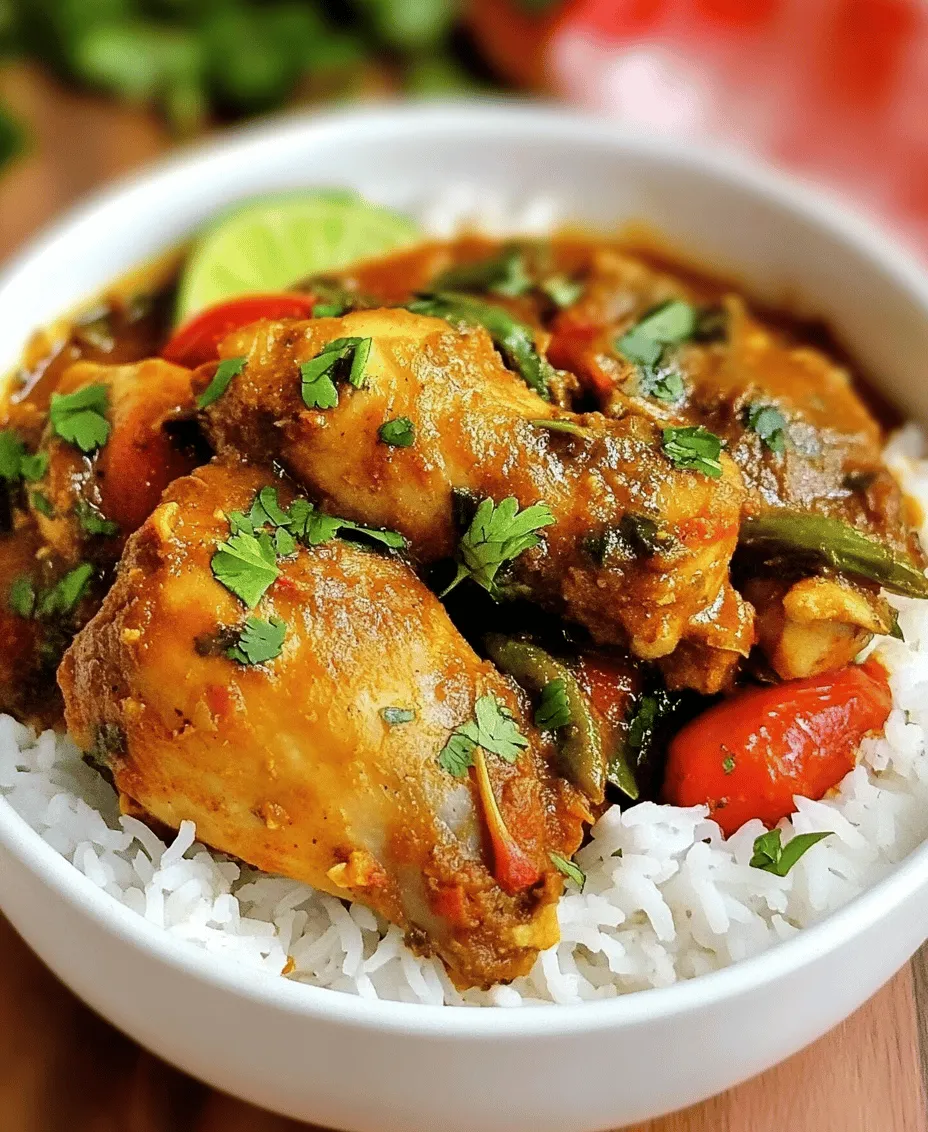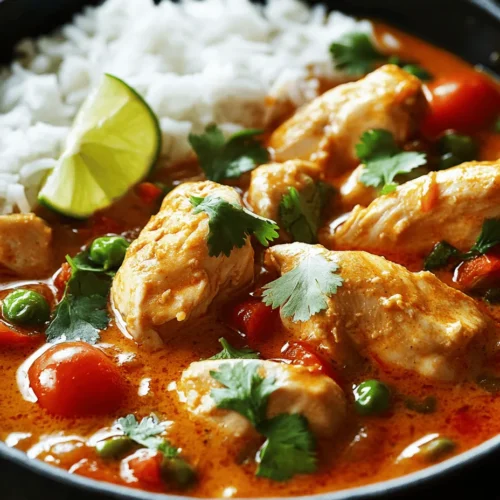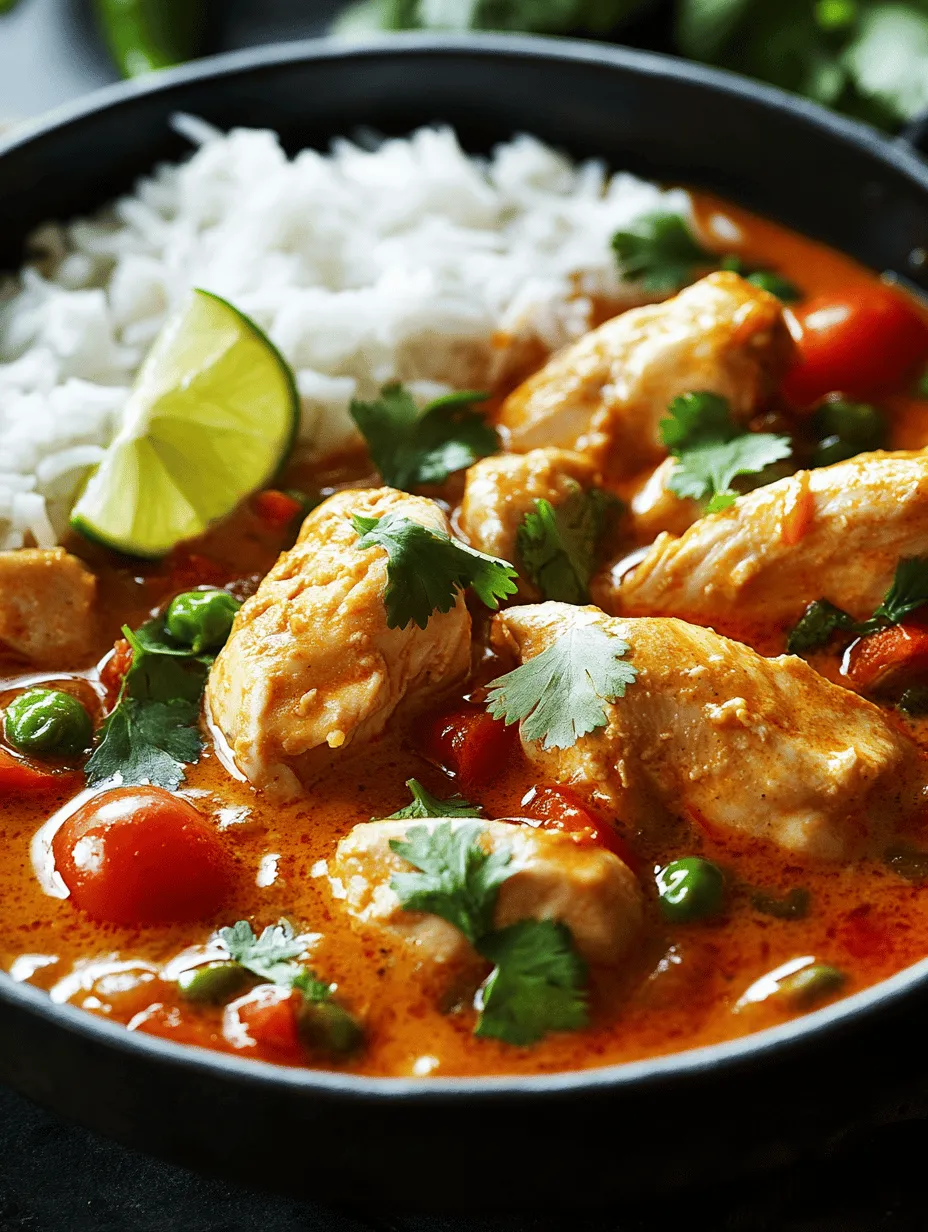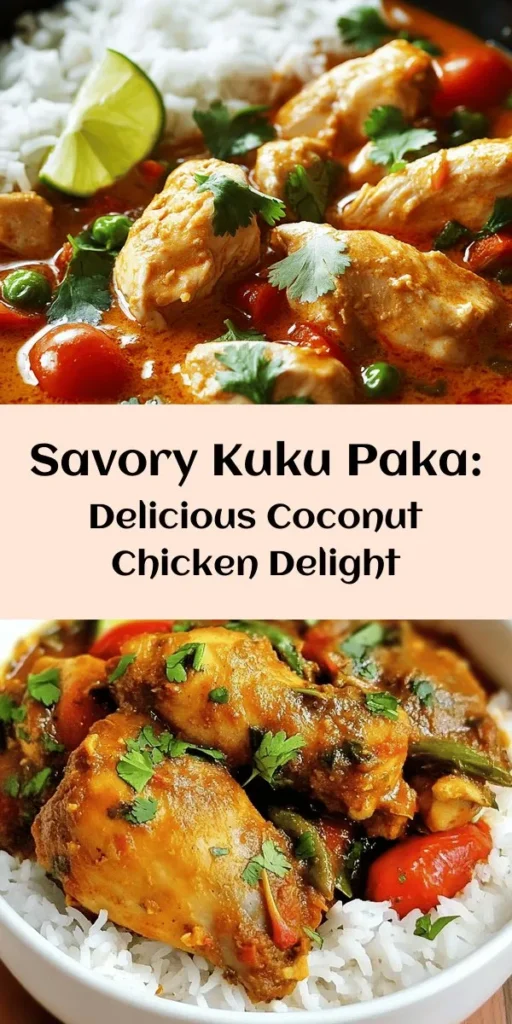Introduction to Kuku Paka: A Flavorful Journey Through East Africa
Kuku Paka is a delightful chicken dish that hails from East Africa, particularly popular in Kenyan cuisine. Known for its combination of tender chicken pieces simmered in a rich coconut sauce, Kuku Paka captivates the palate with its aromatic spices and creamy texture. As a dish that embodies the essence of East African culinary traditions, Kuku Paka is not just a meal; it is a flavorful experience that transports you to the vibrant streets of Nairobi or the coastal towns of Mombasa.
Whether you’re a seasoned chef or a novice in the kitchen, Kuku Paka is an inviting recipe that can easily be replicated in your own home. The beauty of this dish lies in its simplicity and the accessibility of its ingredients, allowing anyone to embark on a culinary adventure into the heart of East Africa. In this article, we will delve into the origins of Kuku Paka, explore the essential ingredients you’ll need, and provide a step-by-step guide to creating this mouthwatering dish that is sure to impress family and friends.
The Cultural Significance of Kuku Paka
To fully appreciate Kuku Paka, it is essential to understand its cultural significance in East African cuisine. This dish is a beautiful representation of the culinary fusion that characterizes the region, where influences from Arab, Indian, and indigenous African cuisines blend harmoniously. The use of coconut milk, for example, reflects the coastal regions’ abundance of coconuts, while the spices used in Kuku Paka hint at the historical spice trade routes that have long influenced East African cooking.
Kuku Paka holds a special place in the hearts of many East Africans, often gracing tables during celebrations, family gatherings, and everyday meals alike. This dish is not only a staple in Kenyan households but has also gained popularity in neighboring countries, showcasing the rich diversity of flavors that the East African region has to offer. Its versatility allows it to be served with various accompaniments, such as rice, ugali (a maize porridge), or chapati, making it a favorite among many.
Key Ingredients for Kuku Paka
Creating an authentic Kuku Paka requires a selection of key ingredients that contribute to its unique flavor profile. Below is an overview of the essential components needed for this dish, each playing a crucial role in crafting the rich and satisfying experience that Kuku Paka offers.
Fresh Chicken
At the heart of Kuku Paka is the chicken, which serves as the primary protein source. Opt for bone-in, skin-on chicken pieces, such as thighs and drumsticks, as they provide maximum flavor and tenderness. The marination process allows the chicken to absorb the spices, ensuring that every bite is infused with flavor.
Coconut Milk
Coconut milk is the soul of Kuku Paka, lending a creamy texture and a subtle sweetness that balances the spices. Its usage in East African cooking is notable, as it adds richness to dishes while also reflecting the region’s tropical climate. When selecting coconut milk, choose full-fat varieties for a more luxurious sauce that clings beautifully to the chicken.
Spices
The distinct taste of Kuku Paka is achieved through a blend of spices that elevate the dish to new heights. Key spices include:
– Curry Powder: This blend of spices adds warmth and depth, infusing the dish with an aromatic quality.
– Turmeric: Known for its vibrant yellow color, turmeric contributes an earthy flavor and is often associated with its health benefits.
– Cumin: With its warm, nutty flavor, cumin enhances the overall complexity of the dish.
– Coriander: This spice adds a citrusy note that brightens the flavors and complements the richness of the coconut milk.
Fresh Vegetables and Herbs
Fresh vegetables and herbs are vital for adding color, texture, and freshness to Kuku Paka. Common additions include onions, garlic, and ginger, which form the aromatic base of the dish. Cilantro (coriander leaves) can also be used as a garnish, providing a burst of freshness that ties the flavors together.
The Step-by-Step Cooking Process
Now that we have explored the origins and significance of Kuku Paka, as well as its key ingredients, it’s time to dive into the step-by-step cooking process. Follow these detailed instructions to ensure a successful cooking experience that will yield a delicious and authentic Kuku Paka.
Marinating the Chicken
The first step in creating Kuku Paka is marinating the chicken, which is crucial for infusing maximum flavor. Here’s how to do it effectively:
1. Prepare the Marinade: In a mixing bowl, combine yogurt, curry powder, turmeric, cumin, coriander, minced garlic, grated ginger, and a pinch of salt. The yogurt helps tenderize the chicken while the spices provide depth of flavor.
2. Coat the Chicken: Place the chicken pieces in the marinade, ensuring they are thoroughly coated. Massage the marinade into the chicken for even distribution.
3. Let it Rest: Cover the bowl with plastic wrap and refrigerate for at least 1 hour, or preferably overnight. This allows the flavors to penetrate the chicken, resulting in a more flavorful dish.
Browning the Chicken
Once the chicken has marinated, the next step is to brown it. This process adds depth of flavor and color to the dish:
1. Heat the Oil: In a large skillet or Dutch oven, heat a few tablespoons of oil (preferably vegetable or coconut oil) over medium-high heat. The oil should shimmer but not smoke.
2. Add the Chicken: Carefully add the marinated chicken pieces to the hot oil in batches, ensuring not to overcrowd the pan. Sear the chicken on all sides until golden brown, which should take about 4-5 minutes per side.
3. Remove and Set Aside: Once browned, remove the chicken from the skillet and set it aside. This step is essential as it creates a flavorful base for the sauce.
4. Sauté the Aromatics: In the same skillet, add finely chopped onions and cook until they are translucent and fragrant. This should take around 3-4 minutes. Follow with minced garlic and grated ginger, sautéing for an additional minute until aromatic.
By taking the time to properly marinate and brown the chicken, you lay the foundation for a dish that is bursting with flavor. In the next sections, we will explore how to bring all these elements together, creating the rich coconut sauce that makes Kuku Paka a true culinary gem of East Africa.

Sautéing Aromatics: Building a Flavor Base with Onions, Garlic, and Ginger
The foundation of any great dish lies in its aromatics, and Kuku Paka is no exception. Begin by finely chopping one large onion, several cloves of garlic, and a piece of fresh ginger. The combination of these ingredients brings depth and richness to the dish, enhancing the overall flavor profile.
In a large skillet or pot, heat a few tablespoons of oil over medium heat. Once the oil is hot, add the chopped onions and sauté them until they become translucent and fragrant, around 5-7 minutes. Next, add the minced garlic and grated ginger, stirring continuously to prevent burning. The aroma of the ingredients melding together is a sure sign that you are on the right track. This step is crucial as it sets the stage for the subsequent flavors to shine through.
Integrating Tomatoes and Spices: A Guide to Balancing Flavors
Once your aromatics are beautifully sautéed, it’s time to integrate the tomatoes and spices. Add two medium-sized ripe tomatoes, chopped, to the skillet, stirring well to combine. The tomatoes not only provide acidity but also contribute to the overall texture of the sauce.
To elevate the flavor further, incorporate a blend of spices that is characteristic of East African cuisine. Add a teaspoon of turmeric, a teaspoon of ground coriander, and a pinch of cumin. For those who enjoy a hint of heat, consider adding a finely chopped green chili at this stage. Allow the mixture to cook for about 10 minutes, stirring occasionally. This cooking process will help the tomatoes break down and meld with the spices, creating a vibrant sauce.
Combining Ingredients: Creating a Harmonious Coconut Sauce
Now that your tomato and spice base is ready, it’s time to introduce the star ingredient: coconut milk. Pour in one can (approximately 400 ml) of coconut milk, stirring gently to combine it with the tomato mixture. The creaminess of the coconut milk will create a luscious sauce that envelops the chicken, adding both flavor and moisture.
At this point, add in your pre-cooked chicken pieces (about 1.5 kg), ensuring they are coated in the sauce. If you’re using raw chicken, make sure to simmer it in the coconut sauce for about 25-30 minutes until fully cooked and tender. Keep the heat on medium-low to allow the flavors to meld together without boiling vigorously.
Cooking the Chicken: Tips for Ensuring Tenderness and Juiciness
If you opted for using raw chicken, there are a few tips to ensure that your Kuku Paka turns out succulent and juicy. First, consider using chicken thighs instead of breasts, as they tend to remain moist during cooking. If you use breasts, avoid overcooking by monitoring their internal temperature, which should reach 165°F (75°C).
Another technique is to marinate the chicken beforehand. A simple marinade of salt, lemon juice, and some of the spices used in the dish can enhance flavor and tenderness. Once the chicken is added to the coconut sauce, cover the skillet with a lid. This will trap steam and moisture, aiding in the cooking process while keeping the chicken tender.
Final Touches: Adjusting Seasoning and Achieving the Desired Sauce Consistency
After the chicken has cooked through, it’s time for the final touches. Taste the sauce and adjust the seasoning as necessary. A pinch of salt and a dash of pepper can make a significant difference. If you prefer a slightly thicker sauce, increase the heat and let it simmer uncovered for a few extra minutes, stirring occasionally. This will allow some of the liquid to evaporate and concentrate the flavors.
If you find the sauce too thick, you can add a splash of water or chicken broth to achieve your desired consistency. Remember, the right balance of flavors is key to making Kuku Paka truly shine.
Serving Suggestions: Pairing Kuku Paka with Rice and Garnishing with Cilantro
Kuku Paka is best served hot, and it pairs beautifully with a side of steamed rice or flatbreads like chapati. The creamy coconut sauce complements the neutral flavors of the rice, creating a comforting and satisfying meal.
To elevate the presentation, garnish the dish with freshly chopped cilantro. Not only does this add a pop of color, but it also brings a refreshing herbal note that balances the richness of the coconut sauce. You can also serve lime wedges on the side to provide a bright, zesty contrast that enhances the dish’s overall flavor.
Tips for Perfecting Your Kuku Paka
To truly master Kuku Paka, consider these expert tips for enhancing both flavor and presentation:
1. Customize Spice Levels: If you enjoy a bit of heat, don’t shy away from adding more green chilies to the sautéed aromatics. Adjust the quantity to suit your taste.
2. Alternative Ingredients: For a different spin on this classic dish, try using shrimp or fish instead of chicken. Both alternatives will also absorb the delicious flavors of the coconut sauce.
3. Side Dishes and Accompaniments: Kuku Paka pairs well with a variety of side dishes. Consider serving it with a simple cucumber salad or sautéed vegetables to add freshness and crunch to your meal.
Nutritional Value of Kuku Paka
Kuku Paka is not only a delectable dish; it also provides a balanced nutritional profile. Here’s a breakdown of its key components:
– Protein: The chicken serves as an excellent source of lean protein, which is essential for muscle maintenance and overall health.
– Healthy Fats: Coconut milk is rich in medium-chain triglycerides (MCTs), which can provide a quick source of energy and may support weight management.
– Vitamins and Minerals: The spices used in Kuku Paka, such as turmeric and garlic, are known for their anti-inflammatory properties and other health benefits, including improved digestion and immunity.
Balancing protein, healthy fats, and carbohydrates, Kuku Paka delivers a wholesome meal that can be enjoyed any day of the week.
Conclusion: Embracing the Flavors of East Africa
Kuku Paka is more than just a meal; it’s an experience that invites you to embrace the vibrant flavors of East African cuisine. Each bite of tender chicken enveloped in creamy coconut sauce is a journey through rich culinary traditions. This dish is perfect for family dinners or special gatherings, where it is sure to impress and delight your guests.
By following the detailed steps outlined in this recipe, you can bring a taste of East Africa to your dining table. With the right ingredients and a bit of patience, Kuku Paka can become a staple in your home cooking repertoire, allowing you to explore the diverse flavors of the world right in your kitchen. Whether you are introducing friends to this dish or enjoying it as a comforting meal, Kuku Paka embodies the spirit of East African hospitality and flavor.



